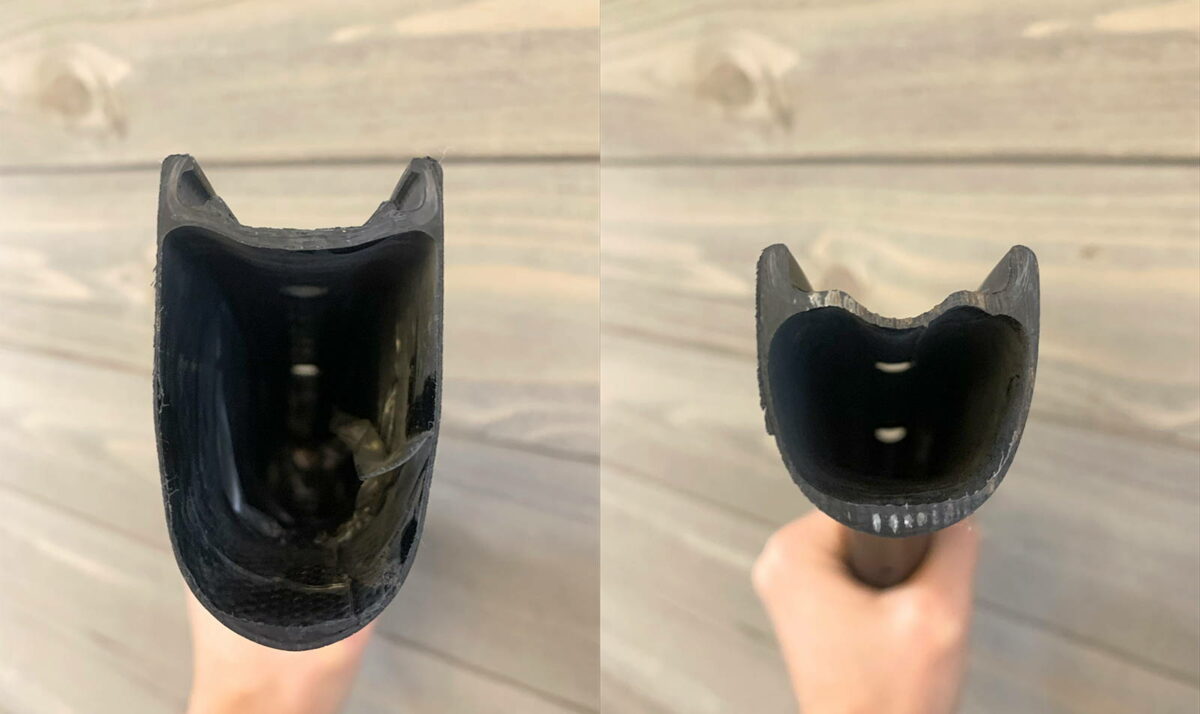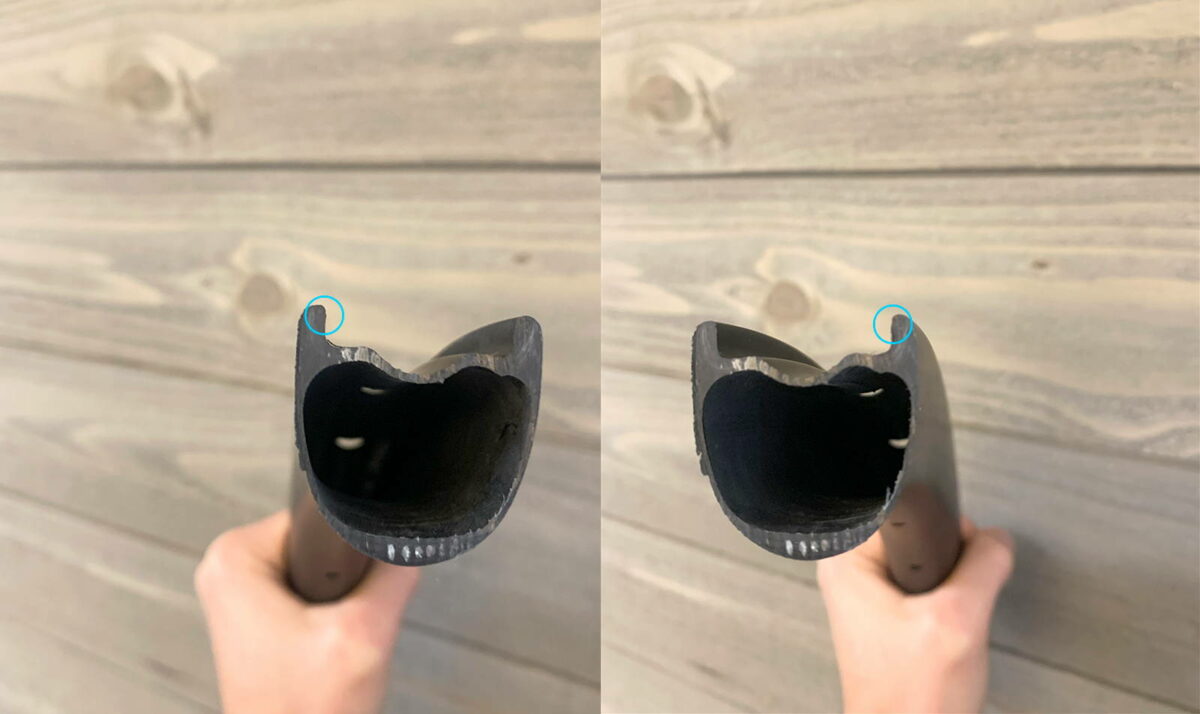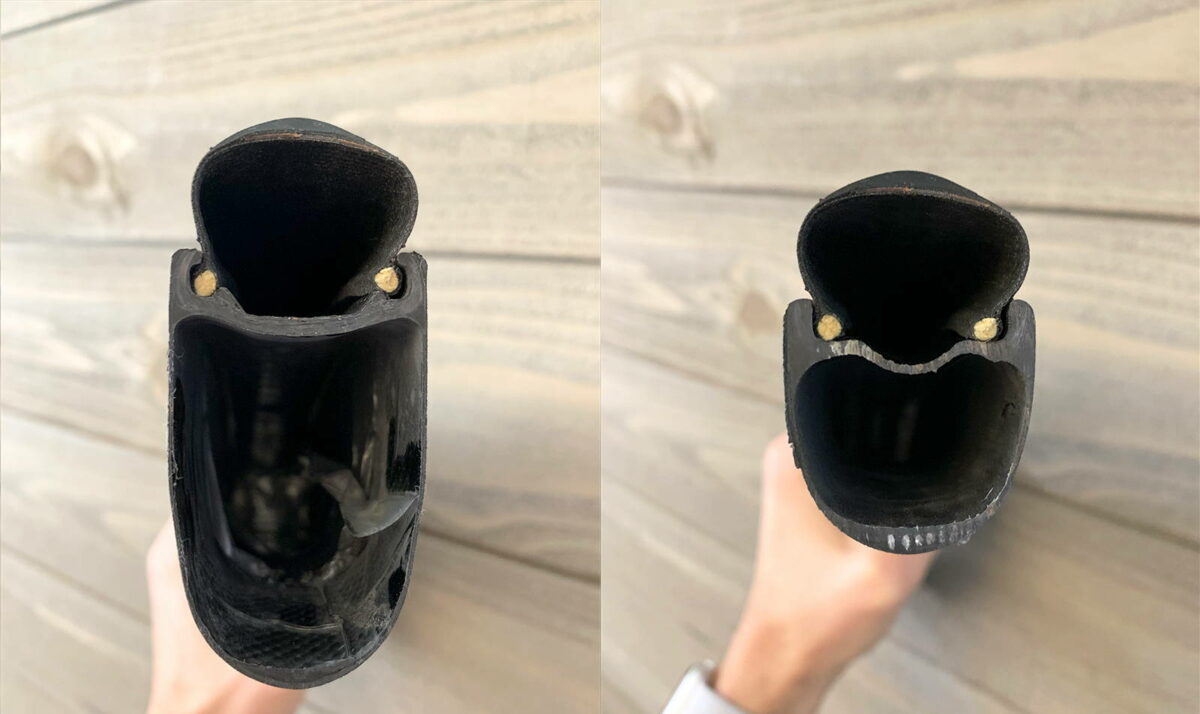What is the difference and what is all the fuss about? This article will walk you through what hooked and hookless rims are, why there are two options, the pros and cons of each, and what we are doing at FLO. Let’s get started.

The Difference Between Hooked & Hookless Rims
The definitions and descriptions of a hooked and hookless rim are fairly self-explanatory. A hooked rim has hooks. Shown below, the “hooks” on a hooked rim are circled in blue.
A rim that is referred to as “hookless” does not contain hooks. The second picture shows a hookless rim. As you can see, the blue circles do not contain hooks.


The History Of Why Rims Have Hooks
You will not find hooks on a car or motorcycle rim. So, why do bicycle rims have hooks? The answer takes us back to the 1970s when, in an attempt to save weight, tires made the switch from rigid, non-folding tires to folding bead tires.
Car and motorcycle tires can stand on their own. However, a bicycle tire does not contain the same structure and will collapse on itself. The thinner casings of a bicycle tire allowed the tire to stretch under pressure. While this saved weight, it led to tire blow offs at high pressures. To prevent blow-offs, hooks were added to the rims to hold the tire in place.
The image below shows a section of a clincher tire installed on both a hooked and hookless rim. You can see how the hook of the hooked rim helps hold the tire beads in place. The tire beads are the yellow circles shown in the picture.
Today, hooks are still used to provide stability and retention of the tires, especially at higher pressures.

Why Is Hookless Even An Option?
With that understanding, you may wonder why are hookless rims an option? There are a couple of reasons.
It’s 2021, Not 1970
Luckily, tires have come a long way since the 1970s. Tire technology today allows for a folding tire to be manufactured where blow-offs are not a concern. However, it’s important to note that this is only for select tires. Plus, it has a lot to do with the wheel/tire relationship as well. More on this later.
Lower Manufacturing Cost
Another reason is cost. Hookless rim are cheaper to manufacture. There is less material involved and less labor so the cost goes down. That’s why some manufacturers push for the use of hookless rims. Make sure to consider why you are picking a hookless rim if you choose to purchase one.
Better Tire/Rim Engagement
To us, the biggest argument for hookless is the way the tire interfaces with the rim. When you have a hook, the tire sidewall can be pushed inward where the hook is located. When you remove that hook, the push inward is removed. This creates a broader, wider stance for the tire.
Tires can be designed with beads that limit this effect for hooked rims but in our opinion, a straight, internal rim structure without a hook makes this easier.
Mountain Biking & Tubeless
What about mountain bike rims? Mountain bikes long ago adopted hookless rims. I am sure most cyclists would agree, the need for mountain biking is much different than road riding. Mountain bike rims are lighter, wider, and have different edges made to withstand impact rather than being designed for aerodynamics. The tires are different too, and a big factor in why the rims work so well being hookless. Mountain bike tires are typically stiffer and, key factor, require a much lower inflation pressure. The lower pressure helps with a number of things but for this case, you are at low risk for blow offs.
Hookless & Tubeless
As previously stated, tire technology has advanced. For instance, the bead lock makes it possible to have a tire that would not stretch enough to blow-off under pressure. We were also introduced to tubeless tires.
In most cases, hookless rims use tubeless tires. While there isn’t a specific reason why a hookless rim could not use a tube, the hookless rims being developed today are intended to be used with tubeless tires. The construction of a tubeless tire is much different than its tubed version. Tubeless tires are stiffer, stronger, and have different beads, making them more suitable for hookless rims. We could get into the pros and cons on tubeless tires, but that’s for another article. We do, however, want to point out that hookless rims have limited tire compatibility. Please be sure to check tire compatibility before purchasing or riding wheels.
What About Hookless & Road & Gravel Wheels?
Hookless works well for mountain bikes because mountain biking requires low tire pressure. However, what about road & gravel wheels? Road & gravel wheels used much higher pressures which creates a concern for blow-offs. Additionally, tubeless tires and hookless rims for road cycling are not as advanced as they are in mountain biking. This means the number of road tires that you can safely run on a hookless rim are limited.
Gravel wheels can fall into the same category of road or mountain bike tires. We recommend 32mm tires on our gravel wheels for certain terrain, and up to 47c for other terrain. Again, the tires that work safely for gravel are limited and you do run this risk of using high pressures that could result in a blow-off.
One of our favorite tires is the Continental GP 5000. This tire comes in a tubeless version but it is recommended that you use hooks.
Does FLO Have Hooked Or Hookless Rims?
At FLO, we make road and gravel carbon wheels. We consider the following when designing wheels for both road and gravel cycling:
- We are committed to developing that fastest products we can make. This means tire selection is critical.
- We do not want to limit the selection tires that can be used on a FLO wheel.
- We want those using FLO wheels to have the choice if they use tubes or tubeless installations.
- We are committed to safety and do not want to develop products that increase the potential of a blow-off scenario.
- Manufacturing cost will not be a factor.
With these items taken into consideration, we currently make all FLO wheels with hooks. While we do believe that hookless rims will have their day in road cycling, unfortunately, tire technology will have to catch up before we can offer wheels that adhere to the guidelines above, without sacrifice.
Our Recommendation
In our opinion, if you are buying mountain bike wheels, hookless is the best option. Because of this, it’s easy to think that hookless would also be a great choice for road and gravel wheels. However, as this article shows, that’s not the case. For road and gravel wheels, we highly recommend rims that have hooks so that you can buy wheels designed around fast tires, are not limited to a small list of tires, and are not risking an unnecessary blow-off.
The only reason a hookless rim for road or gravel makes sense today is if you are ok with the limitations currently imposed on tire selection and pressures. In all other cases, pick a hooked rim.

Co-founder at FLO Cycling. Jon manages the day to day operations and acts as the lead engineer for all FLO products.
